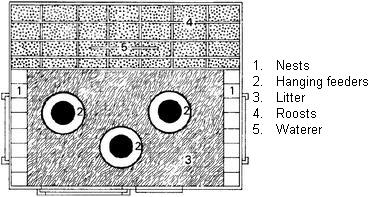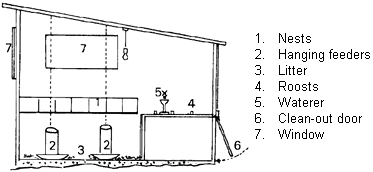



Managing a Small Poultry Flock
By Agri Canada - This publication is a guide for those who wish to keep a few egg-producing chickens for their own use. Chickens that are bred to produce eggs lay considerably more eggs than those bred for meat production.
This publication was originally produced by the British Columbia Department of Agriculture Poultry Branch. Under the provisions of the Federal-Provincial Cooperating Committee on Agricultural Publications, the Canada Department of Agriculture has agreed to print this publication.
Laying birds should produce about 240 eggs during their first year of lay and then enter a molting resting period when then generally stop laying. After the molting period of about 8 weeks, the birds return to lay and will produce 10 to 15% fewer eggs than during the first year. During the second year of lay, the eggs are generally larger but of poorer quality.
Both ready-to-lay pullets and day-old pullet chicks, for those who may wish to raise their own flock, are available commercially (see Replacements)
Laying House
The house should be well constructed, usually with insulated ceiling and walls, depending on the climate in the area. Build it on a well-drained site. Allow 0.15m2 of floor space per bird for Leghorns, and up to 0.25m2 for heavier birds. The house may be rectangular or square with a cottage style, shed, or flat roof. Concrete floors and foundations make cleaning easier and assist in the control of rats and mice.
Floor Plan
Lay out the floor plan so that the house is easy to clean and the bird have only a short distance to travel for feed, water, nests and roosts.
Fig 1. Floor Plan of Laying House

Litter
Cover two thirds of the floor area with 10 to 15 cm of dry sawdust or shavings. This is the birds' scratching area.
Roosts and Dropping Pit
The remaining one third of the floor is covered by the roosts and droppings' pit. The pit has a solid plywood front, 60 cm high, and a top made of 2.5 x 5 cm, electric-welded, galvanized wire to keep the birds out of the pit. Place the roosts (5 x 5 cm wood) 36 cm apart along the length of the pit above the wire. Thus the birds are roosting over a large 'box' which collects the droppings.
Clean-out Doors
For ease of cleaning the dropping pit, construct clean-out doors across the bottom of the back wall adjoining the pit. These doors can be raised and the manure removed without disturbing the birds.
Windows and Lights
Layers require fresh air without drafts in winter. Install windows that slide up and down the outside walls. These can be placed in the front or on both sides. Attach 2.5 cm poultry netting to the inside of the window openings to stop layers from roosting on the window sills and keep out wild birds.
Figure 2. Side view of house contents

Allow 4.5 watts per square metre, or approximately one 60-watt light bulb for every 13m2 of floor area. Laying birds require 16 hours of light per day for maximum egg production, and this may be controlled by installing a time clock in the lighting circuit.
Feeders and Feed
Use one hanging feeder, capable of holding 20 to 25 kg of feed, for every 30 layers. Keep the feeder pan at about the height of the birds' shoulders. Commercial laying rations are a complete feed, so there is no need to feed additional grain or to have the birds run outside. Keep the ration in front of the birds at all times.
Waterers and Water
Install the waterers over the pit between the roosts so that andy spilled water goes into the pit and not onto the litter. Try to avoid spilling water as met manure encourages fly breeding.
Nests
Attach the nests to the wall 60cm above the floor. One nest 30cm square and 30cm high is sufficient for seven layers.
Laying Cages
Egg-producing chickens may be kept in cages. A cage 30cm wide and 45cm deep will house three or four layers. The waterer and feeder are attached to the front of cage above the egg collection tray. Commercially manufactured, Canadian-made cages are available from poultry equipment distributors across Canada.
Mites and Lice
Northern fowl mites are tiny insects that look like pepper and can be found under the feathers below the vent of the bird.
Red mites are very small red or grey insects that feed on the birds' blood at night and can be found in the cracks and crevices of the roosting area during the day.
Lice are about 3mm long and skin-coloured. They are found under the feathers below the vent. Both mites and lice can be controlled by treating the birds with Sevin or Malathion according to the manufacture's recommendations.
Roundworms
If you observe white worms, about 5 to 10cm long in fresh droppings, then your birds should be dewormed. Use a dewormer according to the manufacturer's recommendations.
Culling
Some birds stop laying because of age or disease. Cull such birds and also removed diseased birds in the pen, as they may infect others. A healthy layer has a bright red comb and wattles, the ends of the pubic bones are wide apart, and the vent is large and moist to allow for the passage of eggs. Birds that are not laying have a dried, pale comb and wattles and the pubic bones are close together.
At the end of their laying year the birds may be slaughtered and used as boiling fowl, or they can be force-molted and brought back for second laying period. Information on forced molting is available from provincial departments of agriculture.
Disease Problems
When disease occurs it should be discussed with the local provincial department of agriculture representative or poultry fieldsman. Depending on the nature of the problem, it may be referred to the nearest poultry disease diagnostic laboratory or to a veterinarian.
Replacements
Ready-to-lay pullets are available through commercial hatcheries or from commercial pullet raisers. These birds are generally 20 to 22 weeks old and have been vaccinated for those diseases for which vaccines are available. Pullets usually start to lay when they are from 20 to 24 weeks old, depending on the breed and the manner in which they have been raised.
Alternatively, replacements may be raised from day-old chicks. These young birds should be raised to maturity (20 to 24 weeks) in entirely separate facilities from mature birds. It is undesirable to have more than one age-group in a flock, as it may result in a continuation of disease and the domination of younger birds by those that are more mature.
Raising your own replacement pullets - Brooding
To raise your own birds, purchase day-old pullet chicks from a commercial hatchery and have them vaccinated by the hatchery for Marek's disease. Some people may wish to raise both egg- and meat-type chicks. They may be reared together and are easily identified by the difference in size and appearance when they are about 5 weeks old. The meat breeds may be killed as broilers at 8 to 9 weeks of age, or as roasters at about 14 weeks.
Brood the chicks under electric or gas heat, starting them at 35° C at the level of their backs for the first week. Drop the temperature 3° C each week until they are 6 to 8 weeks old, when the heat can be discontinued. This depends on time of year and temperature in the house.
Keep the chicks close to the heat source by using a brooder guard or similar equipment for the first 7 to 10 days. Place one water jar per 50 chicks close to the heat and distribute chick starter, mash, or crumbles on feed plates or chick starter box lids. These can be replaces with one hanging feeder per 30 chicks at 7 to 10 days. Set the feeder low so that the chicks can reach the feed. They will climb into the feeder to eat for the first few weeks.
Figure 3. Brooder Arrangements

Feeds
Start the chicks on a medicated starter mash or crumbies until 6 to 8 weeks of age, then feed a medicated grower to 20 weeks. Change to all-mash laying ration at this time. These feeds are complete and require no supplementation.
Keep the litter clean and dry and avoid dirty, caked litter around the waterers Supply roosts at 6 weeks of age - 15cm per pullet.
If desired, meat birds can be reared separately and fed on broiler feeds. They will grow faster on these higer-protein, higher-energy rations.
Summary
- Feed a complete layer ration, which may be in the form of mash, crumbles or pellets. No other feed is required.
- Keep waterers clean and full of fresh water.
- Remove any caked litter and replace with dry sawdust or shavings.
- Keep nests clean and filled with fresh, dry shavings.
- Collect eggs twice a day. Clean and cool them to 10 to 12°C as soon as possible.
- Spray for flies as required, following the pesticide manufacturer's recommendations.
- For further information, contact the poultry branch of your provincial department of agriculture.








